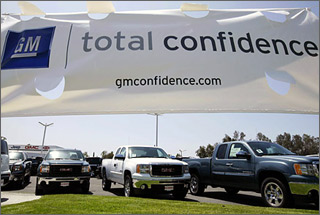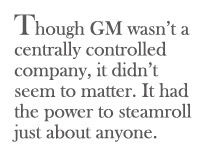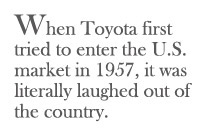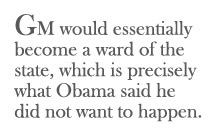From General to Government Motors: Can GM Return to its Former Glory?
From General to Government Motors: Can GM Return to its Former Glory?

NEW YORK: The effort to transform General Motors and Chrysler by using American bankruptcy laws is a huge experiment. If it works, GM, in particular, will re-emerge as a smaller but very competitive and profitable auto company worldwide. But if the process gets bogged down in political wrangling, it’s conceivable that GM might never emerge from bankruptcy and government control. The resulting implosion would be heard around the world.
Before we can project into the future, we have to examine the past. How did GM find itself on the losing end of competition against Toyota Motors in particular and the Japanese in general?

It’s a classic tale of international competition. GM was founded in 1908 by Billy Durant who mashed together a variety of separate companies such as Chevrolet, Cadillac, Oldsmobile, Pontiac and Buick and wanted them to compete against each other. When Alfred P. Sloan took over, he imposed a bit more order, but each of the divisions still had their own design and engineering, stamping, manufacturing, parts and procurement efforts and distribution arms.
Though GM wasn’t a centrally controlled company, it didn’t seem to matter. It had the power to steamroll just about anyone. At the heart of supplying tanks and vehicles to the U.S. military in World War II, GM was instrumental in overwhelming the Japanese with material force. It went on to achieve 50.7 percent of the U.S. market in 1962 and its designs captured the American imagination with such models as the 1959 El Dorado with its impossibly large tail fins.
The Japanese, stung by defeat, were determined to “catch up with and surpass the West.” Thanks in part to U.S. quality gurus who were ignored by a triumphant U.S. auto industry, Toyota came up with the lean manufacturing model. It was a fundamental breakthrough over the mass assembly line technique that the Americans used because it broke the manufacturing process into small teams, each of which had the power to pull the “andon” (or lantern) cords to stop the line. Toyota’s lean system, including just-in-time delivery and kaizen, was born.

When Toyota first tried to enter the U.S. market in 1957, it was literally laughed out of the country. But it never stopped trying, and by the 1970s had begun to reach some scale. At that point the Baby Boom generation started rejecting the idea that they should buy GM, Ford or Chrysler products, as their parents had. They began to perceive that Japanese cars were better, which at this point they undeniably were.
Fast-forward to the mid 1980s. GM was still the largest and most profitable auto company, but it was clearly losing sales. It decided to launch a joint venture with Toyota called New United Motor Manufacturing Inc. at Fremont, Calif., to learn what Toyota was doing so differently.
At first, GM higher-ups rejected the “graduates” of the NUMMI joint venture when they promoted the lean system. Gradually, though, the NUMMI graduates and others with exposure to the Japanese methods began to prove that the system worked. The problem was that the company was already decade behind Toyota because management couldn’t accept the idea that its core manufacturing processes were out of date.

But there was more than just management resistance to change that accounted for GM’s predicament. The United Auto Workers had gained more ground in each contract negotiation since the 1950s and the medical tab for existing and retired workers hit $6 and $7 billion a year. That helped create an American middle class, but it savaged GM’s competitiveness.
When Rick Wagoner became GM’s CEO in 2000 he tried to address these structural challenges by centralizing GM management. More and more GM plants deployed the Toyota system, and Wagoner sought to improve GM’s design, to spend more on R&D and to drive down manufacturing costs to approach those of Toyota’s. As I chronicled in my book, GM was headed for a genuine transformation, one of the most impressive in American industrial history. Unfortunately, the perception that GM made nothing other than gas-guzzling sport utility vehicles lingered.
And then crisis hit in the fall of 2008.
Overall, sales plummeted from roughly 16 million units a year to 9.5 million. GM was hemorrhaging money when Barack Obama became president. Ultimately, accepting the view that GM had failed, Obama’s automotive task force decided to push the company into Chapter 11 bankruptcy on June 1. Prior to this, Wagoner was unceremoniously dumped and replaced by his government designated successor, Fritz Henderson.
Some very positive things could happen in bankruptcy – GM could be allowed to shed thousands of dealers. It could lower its obligations to a million retirees. It could eliminate more factories. If the bankruptcy works, it would be a wakeup call to the Japanese and others that the US is not going to continue to allow its manufacturing base to slip away, and that GM will be a vital competitor in China, South Korea, India, Russia and Poland, among other promising markets.

But at the moment, the greater likelihood is that GM will be turned into the equivalent of the U.S. Postal Service as long as the government owns a majority stake. The Post Office is crippled by political interference in terms of what offices it can close and open, and what services it offers at what price.
And one can already get a taste of the extent of political interference possible. One of the most egregious cases involved Barney Frank, the influential Massachusetts Democrat, who summoned CEO Henderson to complain about GM’s plans to close a parts distribution center in his home district. Because Frank is chairman of the House Financial Services Committee, which oversees the federal funds flowing to GM, Henderson obviously had to relent, at least for a while.
If GM gets bogged down in bankruptcy and political stage-management, the risk is that consumers will lose even more confidence in its products and suppliers will wither on the vine. GM would essentially become a ward of the state, which is precisely what Obama said he did not want to happen. In such a case, the Japanese manufacturers would fill the vacuum in the mass market, along with Hyundai from South Korea. German manufacturers are much more concentrated on the high end of the market, with the exception of Volkswagen. The Japanese already are worried about having the largest slice of the U.S. auto market because of new demands and expectations. “We were very comfortable being just slightly behind,” one Japanese source told me.
So a tremendous drama is playing out. The government has tapped former AT&T Chief Ed Whitacre to become chairman of the board at GM, and he is remaking the entire board. For better or worse, management talent that Rick Wagoner assembled is beginning to vote with their feet and go elsewhere. It’s not clear that Henderson himself can survive. It’s going to be a brand new GM. What nobody knows is whether it can once again become a shining example of American industrial might. In many respects, it’s a test of what “globalization” means to America: does it find the will and wisdom to resuscitate its fallen industrial giant or does it allow it to go the way of the steel, tire, electronics and other lost industries?
William J. Holstein is author of “Why GM Matters: Inside the Race to Transform an American Icon.”